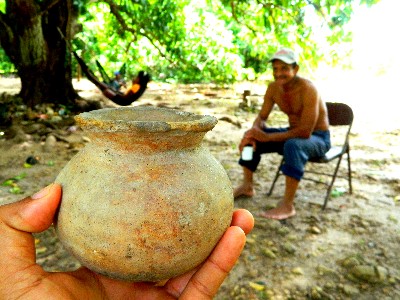500 Years Since Armageddon

By: Ivan Castilla Few people know that this year marks 500 years since the Spaniards visited the district of Chame for the first time. For me it is difficult to judge the events regarding Spain against the native culture and people of Panama. I cannot say if it was a discovery or encounter.
For many historians, with whom I agree, it can not be labeled as a discovery because it is more than proved that there was a millenary presence of native populations in the region. Also, it can not be labeled as an encounter, because of the violent collision, with consequences and social wounds that still affect our people today.
Writers mention that Spanish conqueror Gonzalo de Badajoz was chosen in March 1515 by Pedrarias to explore the isthmus of Panama. Along with his troops of 80 men, he depart heading to Nombre de Dios with instructions to level the land. When he arrived, he found that the fortress built by Nicuesa (another Spanish explorer) was completely destroyed. Badajoz then headed south to Capira, marching through the foothills. It is in this route where he confronted the first native leaders, reaching the surroundings of chief Chamé territory.
Greed, overexploitation and mistreatment of natives were the results of the colonial process, a consequence of the conquest in general. However, it is important because this, without memorializing or celebrating, to know the origins of our people and how we were born as a nation. It is important that we assume our roots, give those roots a face, and project historical destiny.
When Spaniards arrived between 1515 and 1516, corn was grown in the region, along with beans, plantains and several types of fruits. But with a blink of an eye, everything the local people knew was reduced to debris. The Spaniards were seeking gold. Conquerors enslaved and Christianized natives, disbanding their villages and removing their leaders. This changed their lives forever. Military conflicts, forced work and diseases of the old world devastated the population.
By 1522, Chamé natives disappeared; its survivors were sent to encomienda systems or kept captive with intent to populate the emerging city of Panama. Their leader was brought to the city, where he remained until his death. Together with him, several hundred natives lost their lives. What he left is his name as a legacy. Those who remained alive were converted by the conquerors into workers and artisans for the construction of churches. They slowly began a process of acculturation, losing their language and rites, but preserving their name, and a legacy of an unbreakable will, that which defines the “CHAMERO” people.
It is very difficult to the imagine chief of Chame, thinking about the destiny of his people. The native people becoming slaves of foreigners, and his town reduced to ashes. Writers calculated the population at about 4 to 6 inhabitants each square kilometer. This equals between 1,800 and 2,400 people in his village; only 398 natives survived. The survivors were split into the first encomienda system created to populate the newly founded city of Panama (Panama Vieja). Of those, 152 were women, 178 men and 68 children.
This was a population that had no chance of survival. Simply because the generational relief was too weak with an older population, and there were so few women to guarantee the reproduction of people; in other words they become an extinct folk. Cacique Chamé died in the new city in 1532 of shame and anger, as he witnessed the carnal abuse of his daughter by Juan de Cárdenas.
By year 1550 when the encomienda system was abolished, there were only 38 natives remaining. The remaining survivors were sent to Taboga Island to work the land.
This is a story of a town brought to an end, remaining only is the name. By 1522 Chamé becomes a land without people, completely unpopulated and it remains this was until the XVII century.
Trending Tags
